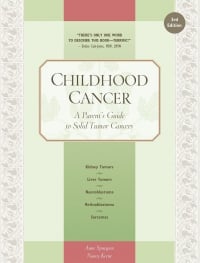Childhood Cancer
Who gets neuroblastoma?
Neuroblastoma is the second most common solid tumor in children (brain tumors are the most common). Each year more than 800 children are diagnosed with neuroblastoma in North America. Boys are diagnosed more often than girls, and there is a slightly higher incidence among White children than among Black children, although Black children are more likely to be diagnosed with high-risk disease. More than half of all neuroblastomas are diagnosed in children ages 2 years or younger, 89 percent are diagnosed before age 5, and 98 percent are diagnosed by age 10. Neuroblastoma is the most common cancer diagnosed in the first year of life.
My son was only 2 years old when his first symptoms began. It was on the day of his third birthday that we received the diagnosis of neuroblastoma. A tumor was attached to his left adrenal gland, and cancer cells were also discovered in his bones and bone marrow. I remember thinking that I had never heard such a strange and ugly sounding word as neuroblastoma before in my life.
For reasons that are not understood, sympathetic nerve cells that are at the very beginning of their growth cycle sometimes begin to divide rapidly and form tumors, instead of maturing normally. To stop this process, the cancer cells must be killed with chemotherapy drugs and radiation, removed with surgery, or encouraged to mature into normal nerve cells with help from drugs called retinoids. Another way to stop this disease is to stimulate the immune system to attack and kill the tumor cells.
Genetic factors
Most neuroblastoma tumors arise spontaneously, and there is no known environmental cause. Approximately 1 to 2 percent of diagnosed children have a family history of neuroblastoma. Affected children from these families are usually diagnosed as infants, and they may have multiple primary tumors. Children with familial neuroblastoma have tumors that develop in various ways. In some cases, they spontaneously disappear; in others, they rapidly grow and spread.
The major neuroblastoma predisposition gene is called ALK, and this gene maps to the short arm of chromosome 2. Mutations in this gene account for 75 percent of hereditary cases. Another gene called PHOX2B predisposes to neuroblastoma in 5 percent of hereditary cases. However, most of these children also have a disorder called central hypoventilation syndrome, or “Ondine’s curse.” The gene responsible for the remaining hereditary cases is not currently known, although there may be a slight increased probability in children with Hirschsprung disease of Neurofibromatosis type 1.
Environmental factors
Although certain types of cancer have been linked to environmental factors, this is not true for neuroblastoma. Many research studies have been conducted to evaluate possible environmental causes, but no prenatal or environmental exposures have consistently or conclusively been associated with an increased risk of developing neuroblastoma. There is nothing parents could have done to prevent their child from developing this disease.
Table of Contents
All Guides- Introduction
- 1. Diagnosis
- 2. Bone Sarcomas
- 3. Liver Cancers
- 4. Neuroblastoma
- 5. Retinoblastoma
- 6. Soft Tissue Sarcomas
- 7. Kidney Tumors
- 8. Telling Your Child and Others
- 9. Choosing a Treatment
- 10. Coping with Procedures
- 11. Forming a Partnership with the Medical Team
- 12. Hospitalization
- 13. Venous Catheters
- 14. Surgery
- 15. Chemotherapy
- 16. Common Side Effects of Treatment
- 17. Radiation Therapy
- 18. Stem Cell Transplantation
- 19. Siblings
- 20. Family and Friends
- 21. Communication and Behavior
- 22. School
- 23. Sources of Support
- 24. Nutrition
- 25. Medical and Financial Record-keeping
- 26. End of Treatment and Beyond
- 27. Recurrence
- 28. Death and Bereavement
- Appendix A. Blood Tests and What They Mean
- Appendix B. Resource Organizations
- Appendix C. Books, Websites, and Support Groups

